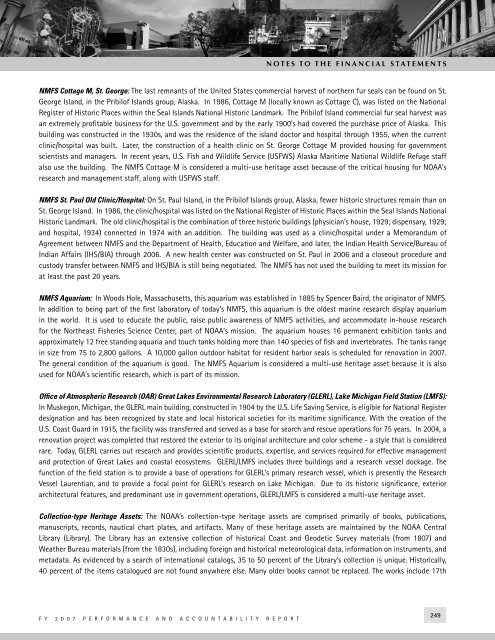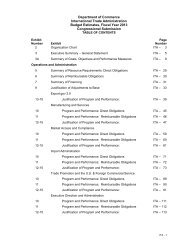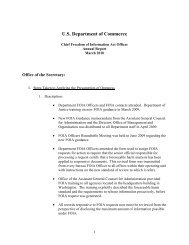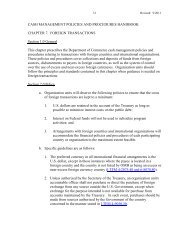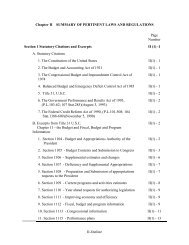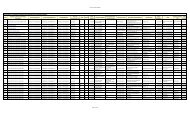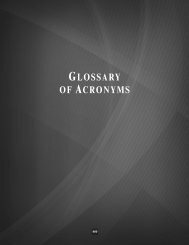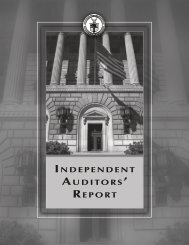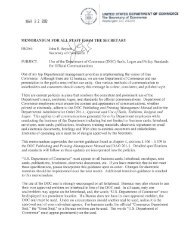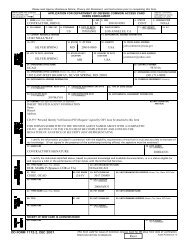United States DEPARTMENT of Commerce
United States DEPARTMENT of Commerce
United States DEPARTMENT of Commerce
You also want an ePaper? Increase the reach of your titles
YUMPU automatically turns print PDFs into web optimized ePapers that Google loves.
N O T E S T O T H E F I N A N C I A L S T A T E M E N T S<br />
NMFS Cottage M, St. George: The last remnants <strong>of</strong> the <strong>United</strong> <strong>States</strong> commercial harvest <strong>of</strong> northern fur seals can be found on St.<br />
George Island, in the Pribil<strong>of</strong> Islands group, Alaska. In 1986, Cottage M (locally known as Cottage C), was listed on the National<br />
Register <strong>of</strong> Historic Places within the Seal Islands National Historic Landmark. The Pribil<strong>of</strong> Island commercial fur seal harvest was<br />
an extremely pr<strong>of</strong>itable business for the U.S. government and by the early 1900’s had covered the purchase price <strong>of</strong> Alaska. This<br />
building was constructed in the 1930s, and was the residence <strong>of</strong> the island doctor and hospital through 1955, when the current<br />
clinic/hospital was built. Later, the construction <strong>of</strong> a health clinic on St. George Cottage M provided housing for government<br />
scientists and managers. In recent years, U.S. Fish and Wildlife Service (USFWS) Alaska Maritime National Wildlife Refuge staff<br />
also use the building. The NMFS Cottage M is considered a multi-use heritage asset because <strong>of</strong> the critical housing for NOAA’s<br />
research and management staff, along with USFWS staff.<br />
NMFS St. Paul Old Clinic/Hospital: On St. Paul Island, in the Pribil<strong>of</strong> Islands group, Alaska, fewer historic structures remain than on<br />
St. George Island. In 1986, the clinic/hospital was listed on the National Register <strong>of</strong> Historic Places within the Seal Islands National<br />
Historic Landmark. The old clinic/hospital is the combination <strong>of</strong> three historic buildings (physician’s house, 1929; dispensary, 1929;<br />
and hospital, 1934) connected in 1974 with an addition. The building was used as a clinic/hospital under a Memorandum <strong>of</strong><br />
Agreement between NMFS and the Department <strong>of</strong> Health, Education and Welfare, and later, the Indian Health Service/Bureau <strong>of</strong><br />
Indian Affairs (IHS/BIA) through 2006. A new health center was constructed on St. Paul in 2006 and a closeout procedure and<br />
custody transfer between NMFS and IHS/BIA is still being negotiated. The NMFS has not used the building to meet its mission for<br />
at least the past 20 years.<br />
NMFS Aquarium: In Woods Hole, Massachusetts, this aquarium was established in 1885 by Spencer Baird, the originator <strong>of</strong> NMFS.<br />
In addition to being part <strong>of</strong> the first laboratory <strong>of</strong> today’s NMFS, this aquarium is the oldest marine research display aquarium<br />
in the world. It is used to educate the public, raise public awareness <strong>of</strong> NMFS activities, and accommodate in-house research<br />
for the Northeast Fisheries Science Center, part <strong>of</strong> NOAA’s mission. The aquarium houses 16 permanent exhibition tanks and<br />
approximately 12 free standing aquaria and touch tanks holding more than 140 species <strong>of</strong> fish and invertebrates. The tanks range<br />
in size from 75 to 2,800 gallons. A 10,000 gallon outdoor habitat for resident harbor seals is scheduled for renovation in 2007.<br />
The general condition <strong>of</strong> the aquarium is good. The NMFS Aquarium is considered a multi-use heritage asset because it is also<br />
used for NOAA’s scientific research, which is part <strong>of</strong> its mission.<br />
Office <strong>of</strong> Atmospheric Research (OAR) Great Lakes Environmental Research Laboratory (GLERL), Lake Michigan Field Station (LMFS):<br />
In Muskegon, Michigan, the GLERL main building, constructed in 1904 by the U.S. Life Saving Service, is eligible for National Register<br />
designation and has been recognized by state and local historical societies for its maritime significance. With the creation <strong>of</strong> the<br />
U.S. Coast Guard in 1915, the facility was transferred and served as a base for search and rescue operations for 75 years. In 2004, a<br />
renovation project was completed that restored the exterior to its original architecture and color scheme - a style that is considered<br />
rare. Today, GLERL carries out research and provides scientific products, expertise, and services required for effective management<br />
and protection <strong>of</strong> Great Lakes and coastal ecosystems. GLERL/LMFS includes three buildings and a research vessel dockage. The<br />
function <strong>of</strong> the field station is to provide a base <strong>of</strong> operations for GLERL’s primary research vessel, which is presently the Research<br />
Vessel Laurentian, and to provide a focal point for GLERL’s research on Lake Michigan. Due to its historic significance, exterior<br />
architectural features, and predominant use in government operations, GLERL/LMFS is considered a multi-use heritage asset.<br />
Collection-type Heritage Assets: The NOAA’s collection-type heritage assets are comprised primarily <strong>of</strong> books, publications,<br />
manuscripts, records, nautical chart plates, and artifacts. Many <strong>of</strong> these heritage assets are maintained by the NOAA Central<br />
Library (Library). The Library has an extensive collection <strong>of</strong> historical Coast and Geodetic Survey materials (from 1807) and<br />
Weather Bureau materials (from the 1830s), including foreign and historical meteorological data, information on instruments, and<br />
metadata. As evidenced by a search <strong>of</strong> international catalogs, 35 to 50 percent <strong>of</strong> the Library’s collection is unique. Historically,<br />
40 percent <strong>of</strong> the items catalogued are not found anywhere else. Many older books cannot be replaced. The works include 17th<br />
F Y 2 0 0 7 P E R F O R M A N C E A N D A C C O U N T A B I L I T Y R E P O R T<br />
249


